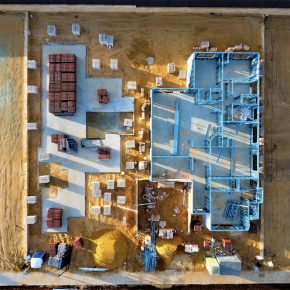
How to Position Portable Toilets on Construction Sites
Construction sites are bustling hubs of activity, with workers dedicated to completing projects efficiently and on time. Amidst the chaos, one often overlooked aspect is the placement of portable toilets. However, strategic positioning of these facilities can significantly impact productivity, worker satisfaction, and even safety. This guide delves into the importance of proper positioning and offer practical tips to optimise portable toilet placement on construction sites…
Understand Worker Flow
– Before determining where to place portable toilets, it’s crucial to understand the flow of workers on the construction site. Identify high-traffic areas, such as work zones, break areas, and entry/exit points.
– Position toilets in convenient locations that minimise time spent walking to and from them. Placing them near work areas reduces downtime and increases productivity.
Ensure Accessibility
– Accessibility is paramount, especially for workers with disabilities or mobility issues. Portable toilets should comply with accessibility standards and be easily reachable from all parts of the construction site. Installing sufficient portable toilets is very important. Do you still need portable toilets? Then you can easily order portable toilets from ToypeK. With this supplier you can even customise the mobile toilets to your preferences.
– Consider placing toilets on stable, flat surfaces to accommodate wheelchair access and prevent accidents.
Prioritise Hygiene and Privacy
– Workers value privacy and cleanliness when using portable toilets. Avoid placing them in highly visible or congested areas to maintain privacy.
– Place toilets away from food areas and work zones to minimise odours and contamination risks. Regular cleaning and maintenance are essential to uphold hygiene standards.
Account for Site Conditions
– Site conditions play a significant role in determining optimal toilet placement. Consider factors like terrain, weather, and environmental hazards.
– On uneven terrain, use levelling blocks or platforms to stabilise toilets and prevent tipping. In areas prone to flooding or extreme weather, elevate toilets or relocate them to higher ground to avoid damage.
Ensure Regulatory Compliance
– Construction sites must adhere to regulations regarding sanitation and worker health. Familiarise yourself with local codes and regulations governing portable toilet placement.
– Ensure that the number of toilets provided meets regulatory requirements based on the size of the workforce and duration of the project. Regular inspections and compliance checks are essential to avoid penalties.
Communicate with Workers
– Involve workers in the decision-making process regarding portable toilet placement. Solicit feedback on existing facilities and potential improvements.

– Maintain open lines of communication to address any concerns or issues related to toilet accessibility, cleanliness, or location promptly.
Strategic positioning of portable toilets on construction sites
Strategic positioning of portable toilets on construction sites is more than just a matter of convenience; it’s a crucial aspect of promoting worker well-being, productivity, and regulatory compliance. By understanding worker flow, ensuring accessibility, prioritising hygiene, accounting for site conditions, and fostering communication with workers, construction managers can optimise toilet placement and contribute to a safer, more efficient work environment.
By implementing these practical tips, construction sites can enhance worker satisfaction, minimise downtime, and ultimately, improve project outcomes. Remember, investing time and effort into thoughtful toilet placement yields valuable returns in terms of productivity and worker morale.
Latest news

26th July 2024
Enfield Speciality Doors completes world-class project for Atlas Copco HQ
A rundown office and warehouse building completely transformed into a modern headquarters for Atlas Copco has been fitted with more than 120 internal fire doors from Enfield Speciality Doors.
Posted in Access Control & Door Entry Systems, Articles, Building Industry News, Building Products & Structures, Building Systems, Case Studies, Doors, Interior Design & Construction, Interiors, Posts, Restoration & Refurbishment, Retrofit & Renovation, Security and Fire Protection, Sustainability & Energy Efficiency, Timber Buildings and Timber Products, Wooden products
26th July 2024
Abloy UK launches new white paper
Abloy UK, a leading provider of security and access control solutions, has launched a new white paper.
Posted in Access Control & Door Entry Systems, Architectural Ironmongery, Articles, Building Industry News, Building Products & Structures, Building Services, Doors, Facility Management & Building Services, Health & Safety, Information Technology, Innovations & New Products, Publications, Research & Materials Testing, Security and Fire Protection
26th July 2024
MCRMA Member Profile: David Roy, Director of Roofconsult
David Roy of MCRMA member company Roofconsult has more than 50 years’ experience to draw upon working in the building envelope sector and a unique perspective on how it has changed in that time.
Posted in Articles, BIM, Infrastructure & CAD Software, Building Associations & Institutes, Building Industry News, Building Products & Structures, Building Services, Building Systems, Cladding, Information Technology, Restoration & Refurbishment, Retrofit & Renovation, Roofs, Walls
26th July 2024
Strand: Enhancing Door Functionality and Safety
Craig Fox, Sales Director for Strand Hardware, outlines how door industry professionals might apply door limiting stays…
Posted in Architectural Ironmongery, Articles, Building Industry News, Building Products & Structures, Building Services, Doors, Facility Management & Building Services, Health & Safety, Restoration & Refurbishment, Retrofit & Renovation
 Sign up:
Sign up: